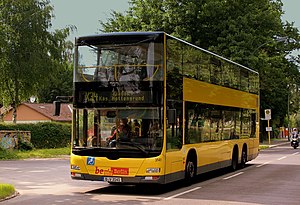| Bus transport in Berlin | |
|---|---|
 | |
 MAN Lion's City DD double decker bus | |
| Overview | |
| Locale | Berlin, Germany |
| Transit type | Public bus transport |
| Number of lines | 152 (+49 night lines) |
| Number of stations | 6.589 |
| Website | https://www.bvg.de/en |
| Operation | |
| Began operation | 1846 |
| Operator(s) | Berliner Verkehrsbetriebe |
| Number of vehicles | 1,550 |
| Technical | |
| System length | 1,798 km (1,117 mi) |






Bus transport is the oldest public transport service in Berlin, the capital city of Germany, having been introduced in 1846. Since 1929, services have been operated by the Berlin Transport Company (German: Berliner Verkehrsbetriebe, BVG), although during the Cold War-era division of the city they operated in West Berlin only. In East Berlin the public transport agency split off from the BVG and rebranded as BVB, operating the buses in the Soviet sector of Berlin.
Currently, the BVG's fleet consists of 1,550 vehicles, which cover 300,000 kilometres per day.
As many transit operators around the world, the BVG has set a goal to have their entire fleet running without emissions until the year 2030. For this reason the number of battery electric busses in Berlin is steadily rising.[1]
- ^ "Electromobility | BVG Company". Retrieved 2023-07-19.